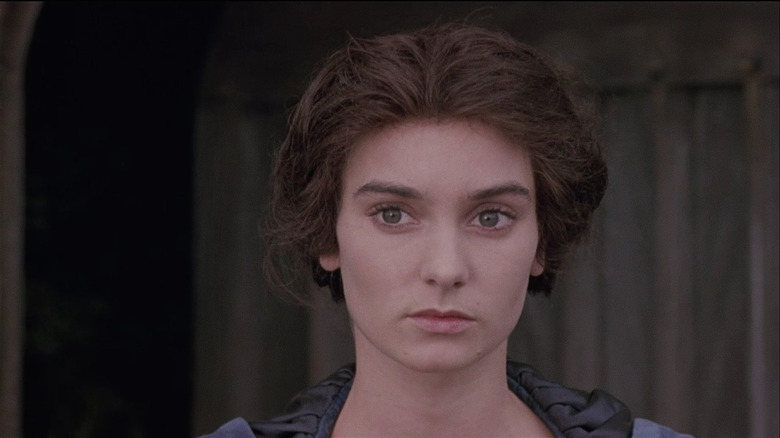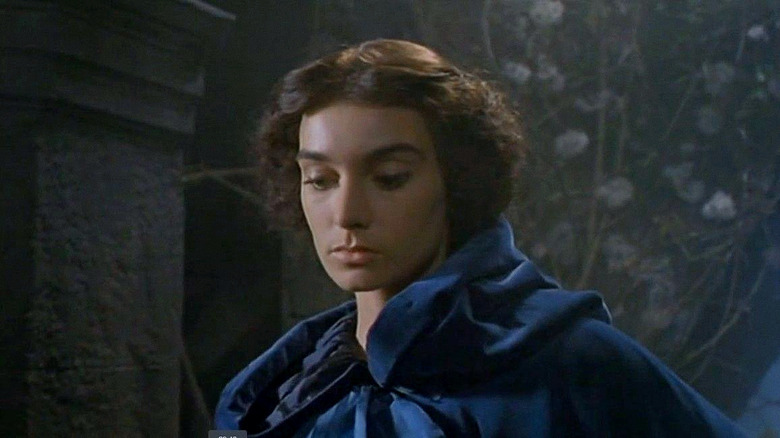The Surprising Role Sinéad O'Connor Played In Wuthering Heights
Emily Brontë's 1847 barn burner of a debut (and final) novel, "Wuthering Heights," has the not unique distinction of being an extraordinary piece of writing without any great screen adaptations to its name. Plenty of great books have been adapted into great films (Francis Ford Coppola's re-envisioning "Heart of Darkness," Joseph Conrad's harrowing descent into the European colonization of Africa, into "Apocalypse, Now," a terrifying parable of American imperial arrogance in Vietnam comes right to mind).
But even more great literary adaptations litter the studio rubbish heaps, the victims of crippling executive intervention, directors who took a Coppola-like big swing and missed, and most common of all, filmmakers who didn't take a big swing and ended up with perfectly fine, perfectly flat, one-for-one translations that ultimately leave you feeling the story just should have stayed on the page.
Paramount's 1992 take on "Wuthering Heights" ultimately belongs to that last category. And it's a shame, because the project had so much potential. Mirroring its source author, the film was prolific television director Peter Kosminsky's first theatrical feature (and ended up being his last). It was scored by the legendary Japanese musician Ryuichi Sakamoto and cut by the veteran editor Tony Lawson ("Barry Lyndon," "Straw Dogs"). It featured an ample ensemble of accomplished stage and character actors like Janet McTeer, John Woodvine, and Simon Ward, and was headed up by an ideal Heathcliff/Cathy in Ralph Fiennes and Juliette Binoche — and it was Fiennes' first role!
Conspicuously absent from the credits is the film's most intriguing cameo, the bit of stunt casting that, in hindsight, remains the most potent site of untapped potential: Sinéad O'Connor as Emily Brontë herself.
Ungovernable passions
The iconoclastic Irish artist died today at the tragically young age of 56. In his own barn burner of a eulogy, /Film's Jeremy Smith called O'Connor's rending of a picture of Pope John Paul II on SNL "one of the bravest acts in TV history." Indeed, O'Connor's temerity to go up in such a public way against the Catholic Church, and the conservative right by extension, constitutes one of the bravest acts in all of pop cultural history.
But the fact that O'Connor's name will endure for generations — I've no doubt that she'll outlast most of her musical peers from the era — has as much to do with her righteous solidarity with the broken and dispossessed all across the world as it does with her tender heart, the surprisingly meek and passionate soul that emanates from her voluminous musical catalog and limited screen appearances.
O'Connor was actually shy underneath all of the fire and fury, which made her the perfect person to play Emily Brontë. In contrast with the withdrawn, strenuously obedient Charlotte and laconic, straightforward Anne, Emily comes across on the page as wild, ungovernable, subject only to the whims of her fierce passions. Yet she too had a poet's heart, and with it came a taciturn temperament, a natural and often unruly shyness.
"Wuthering Heights" opens on the wild and windy moors. A lone, penitent figure in a hooded robe walks toward a stone cottage overtaken by moss and vines. O'Connor begins the opening narration in voiceover, and once inside the hallowed habitation, unveils her angular, angelic face. She appears for no more than five minutes as Brontë, but her singular, assured, disarmingly humble presence sets the viewer up for a movie that never again reaches the heights she attained. It's the blessing and curse that Sinéad O'Connor bestowed on everyone she worked with, and everything she worked on.

